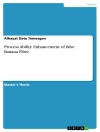Diploma Thesis from the year 2006 in the subject Textile, Print, Crafting, grade: 1, 7, Albstadt-Sigmaringen University, language: English, abstract: This diploma thesis “APPLYING FMEA IN THE KNITTING PROCESS” shows how to develop a FMEA in the production process of the knitting department. The quality control shows several important defects, which have to be improved and reduced.
The FMEA (Failure Mode and Effect Analysis) is an analysis to detect and prevent potential failures and defects in the quality assurance.
While getting familiar with the production procedure of knitting fabric the idea to develop a FMEA became more interesting. In the textile industry the used methods for predicting quality assurance are still not very common. The knitting department is still using a classic strategy of analysing and preventing defects.
First there was the need to define a responsible team to develop a FMEA process. The team members are selected from different areas in the production. To learn about the purposes and benefits of an FMEA the chief of the team should visit a training-program for moderators.
The process FMEA includes 13 steps to follow and conduct a FMEA. Process FMEA, because it focuses on the failure modes caused by process or assembly deficiencies.
The most important reason for conducting a FMEA is to improve its process and quality.
The first step in developing a FMEA is to define the complete production process of knitting. Therefore it is necessary to identify the detailed functions of the workstations. Further the most important and critical defects have to be defined with its causes and defects. The Cause-Effect-Diagram is a helpful method to analyse the root causes. The defects are listed by its appearance according to the functions in the process. It is important to do an analysis of the total percentages of defects before starting to apply the FMEA process in the procedure.
Risk evaluation is in charge of evaluating the defects according to severity, occurrence and detection. The ranking system is between 10 and 1, in which 10 identifies a very high risk and 1 a minor risk. Severity applies to the importance of the defect, occurrence to the frequency, and detection to the efficiency of detecting the defect.
At last the Risk Priority Number (RPN) is calculated by multiplying severity by occurrence and by detection to define the total potential failure or defect. Recommended actions are to be defined in order to give solution and reduce the problems in the procedure.
Inkeri Walser
Applying FMEA in the knitting process [PDF ebook]
Applying FMEA in the knitting process [PDF ebook]
Beli ebook ini dan dapatkan 1 lagi PERCUMA!
Bahasa Inggeris ● Format PDF ● ISBN 9783638019958 ● Saiz fail 1.8 MB ● Penerbit GRIN Verlag ● Bandar raya München ● Negara DE ● Diterbitkan 2007 ● Edisi 1 ● Muat turun 24 bulan ● Mata wang EUR ● ID 3565851 ● Salin perlindungan tanpa












